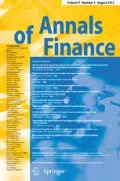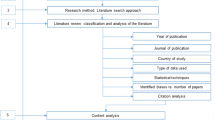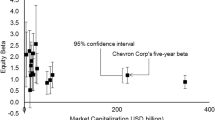Abstract
In several countries a major factor contributing to the current economic crisis was massive borrowing to fund investment projects on the basis of, in retrospect, grossly optimistic valuations. The purpose of this paper is to initiate an approach to project valuation and risk management in which ‘behavioural’ factors—Keynes’ ‘animal spirits’ or Greenspan’s ‘irrational exuberance’—can be explicitly included. An appropriate framework is risk-neutral valuation based on the use of the numéraire portfolio—the ‘benchmark’ approach advocated by Platen and Heath (A benchmark approach to quantitative finance. Springer, Berlin, 2006). In the paper, we start by discussing the ingredients of the problem: ‘animal spirits’, financial instability, market-consistent valuation, the numéraire portfolio and structural models of credit risk. We then study a project finance problem in which a bank lends money to an entrepreneur, collateralized by the value of the latter’s investment project. This contains all the components of our approach in a simple setting and illustrates what steps are required. In a final section, we briefly discuss the econometric problems that need to be solved next.










Similar content being viewed by others
Notes
The phrase is an allusion to the classical term spiritus animalis conveying the idea of animation, not atavism!
Akerlof and Shiller (2009) somehow understate the reach of Matsusaka and Sbordone’s argument.
Ponzi units are named after 1920s con artist Charles Ponzi.
Minsky’s view that investors predominently form their opinion based on recent data is related to the availability heuristics first analyzed by Tversky and Kahneman (1973): to make their decisions, individuals use short cuts (heuristics) such as extrapolating from immediately available information, and in particular from the recent past.
See MacLean et al. (2011) for a comprehensive account of investment based on the growth-optimal or ‘Kelly’ criterion
References
Akerlof, G.: Behavioral macroeconomics and macroeconomic behavior. Am Econ 47, 25–47 (2003) (2001 Nobel Prize lecture)
Akerlof, G., Shiller, R.: Animal Spirits. Princeton: Princeton University Press (2009)
Aspachs, A., Goodhart, C., Tsomocos, D., Zicchino, L.: Towards a measure of financial fragility. Ann Financ 3, 37–74 (2007)
Baker, M., Wurgler, J.: Investor sentiment and the cross-section of stock returns. J Financ 61(4), 1645–1680 (2006)
Bhar, R., Hamori, S.: Hidden Markov Models: Applications To Financial Economics. Berlin: Springer (2004)
Cesari, G., Aquilina, J., Charpillon, N., Filipović, Z.: Modelling, Pricing, and Hedging Counterparty Credit Exposure: A Technical Guide. Berlin: Springer (2010)
Davos: World Economic Forum. http://www.weforum.org (2012)
Duffie, D., Pan, J., Singleton, K.: Transform analysis and asset pricing for affine jump-diffusions. Econometrica 68, 1343–1376 (2000)
Fisher, K., Statman, M.: Investor sentiment and stock returns. Financ Anal J 56, 16–23 (2000)
Fisher, K., Statman, M.: Consumer confidence and stock returns. J Portfolio Manag 30, 115–127 (2003)
Föllmer, H., Schied, A.: Stochastic Finance: An Introduction to Discrete Time, 3rd edn. Berlin: de Gruyter (2011)
Geman, H., El Karoui, N., Rochet, J.C.: Changes of numéraire, changes of probability measures and pricing of options. J Appl Probab 32, 443–458 (1995)
Glasserman, P.: Monte Carlo Methods in Financial Engineering. Berlin: Springer (2003)
Goodhart, C., Sunirand, P., Tsomocos, D.: A risk assessment model for banks. Ann Financ 1, 197–224 (2005)
Granger, C.: Investigating causal relations by econometric models and cross-spectral methods. Econometrica 37, 424–438 (1969)
Hertzberg, M.P., Beckman, B.A.: Business cycle indicators: revised composite indexes. Bus Cond Dig 29, 97–102 (1989)
Howrey, E.P.: The predictive power of the index of consumer sentiment. Brookings Pap Econ Act 1, 175–207 (2001)
Hull, J., White, A.: Valuing credit default swaps I: no counterparty default risk. J Deriv 8, 29–40 (2001)
Hunt, P., Kennedy, J.: Financial Derivatives in Theory and Practice. London: Wiley (2004)
Jansen, W.J., Nahuis, N.J.: The stock market and consumer confidence: European evidence. Econ Lett 79(1), 89–98 (2003)
Kemp, M.: Market Consistency: Model Calibration in Imperfect Markets. London: Wiley (2009)
Keynes J (2007) The General Theory of Employment, Interest and Money, 1936. Palgrave Macmillan edition
Knight, F.: Risk, Uncertainty and Profit. No. 31 in Hart, Schaffner, and Marx Prize Essays, Houghton Mifflin (1921)
Lando, D.: Credit Risk Modeling. Princeton: Princeton University Press (2004)
Lemmon, M., Portniaguina, E.: Consumer confidence and asset prices: some empirical evidence. Rev Financ Stud 19(4), 1499–1529 (2006)
Long, J.: The numéraire portfolio. J Financ Econ 26, 29–69 (1990)
Longstaff, F., Schwartz, E.: A simple approach to valuing risky fixed and floating rate debt. J Financ 50, 789–819 (1995)
Longstaff, F., Schwartz, E.: Valuing American options by simulation: a simple least-squares approach. Rev Financ Stud 14, 113–147 (2001)
MacLean, L., Thorp, E., Ziemba, W. (eds.): The Kelly Capital Growth Investment Criterion. World Scientific, Singapore (2011)
Mamon, R., Elliott, R.: Hidden Markov Models in finance. Berlin: Springer (2007)
Markit: PMI and economic data, http://www.markit.com/en/products/research-and-reports/pmis/pmi.page (2011)
Matsusaka, J., Sbordone, A.: Consumer confidence and economic fluctuations. Econ Enq 33, 296–318 (1995)
McCulley, P.: The shadow banking system and hyman minskys economic journey. In: Insights into the Global Financial Crisis, Research Foundation of the CFA Institute (2009)
Merton, R.: On the pricing of corporate debt: the risk structure of intrest rates. J Financ 29, 449–470 (1974) reprinted in Merton (1992)
Merton, R.: Continuous-time Finance. Oxford: Wiley-Blackwell (1992)
Minsky, H.: The financial instability hypothesis. Working Paper 74, The Levy Economics Institute of Bard College (1992)
Minsky, H.: Stabilizing an Unstable Economy. New York City: McGraw-Hill Professional (2008)
Platen, E., Heath, D.: A Benchmark Approach to Quantitative Finance. Berlin: Springer (2006)
Poor, H., Hadjiliadis, O.: Quickest Detection. Cambridge: Cambridge University Press (2009)
Rigobon, R., Sack, B.: Noisy macroeconomic announcements, monetary policy and asset prices. In: Campbell, J. (ed.) Asset Prices and Monetary Policy, pp. 335–370. University of Chicago Press, Chicago (2008)
Shleifer, A.: Inefficient markets: an introduction to behavioral finance. In: Oxford University Press, Clarendon Lectures in Economics (2000)
Tversky, A., Kahneman, D.: Availability: a heuristic for judging frequency and probability. Cognit Psychol 5(2), 207–232 (1973)
Utaka, A.: Confidence and the real economy: the Japanese case. Appl Econ 35, 337–342 (2003)
Author information
Authors and Affiliations
Corresponding author
Additional information
Sébastien Lleo gratefully acknowledges support from Région Champagne Ardennes and the European Union through the RiskPerform grant.
Rights and permissions
About this article
Cite this article
Andruszkiewicz, G., Davis, M.H.A. & Lleo, S. Taming animal spirits: risk management with behavioural factors. Ann Finance 9, 145–166 (2013). https://doi.org/10.1007/s10436-012-0217-y
Received:
Accepted:
Published:
Issue Date:
DOI: https://doi.org/10.1007/s10436-012-0217-y
Keywords
- Collateralized loans
- Animal spirits
- Confidence indices
- Market-consistent valuation
- Numéraire portfolio
- Structural credit risk models




